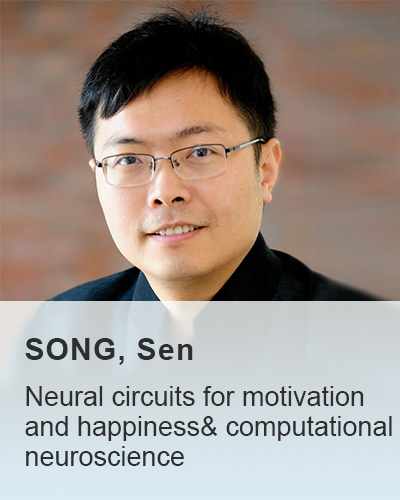 |
PI, IDG/McGovern Institute for Brain Research at Tsinghua
PI, School of Medicine
Office Phone: +86-10-62773357
Email: sen.song@gmail.com LinkedIn:http://www.brainmatrix.me |
[Research Focus]
Since my childhood, I have been fascinated by two questions: 1) why human can do intelligent things that computers cannot do. 2) what is a good life. I am glad that I found out that I can tackle these fundamental questions with the tools provided by modern neuroscience, and this incredible interdisplinary field of brain research provides many exciting opportunities. Since coming to Tsinghua, I have also been increasingly interested in brain related medical problems, like depression and anxiety disorders, which challenge us and makes life difficult for many people. The overarching theme in my lab is what I call connectomics and functional connectomics, where we take inspiration from genomics and functional genomics to aim at arriving at a circuit diagram of the brain and relate circuit structures to their functions and elucidate the computational processes carried out by those circuits. Our lab's research include:
1. Develop computational tools and analyze large volumes of data generated by connectomics and genomics research
2. Find out the neural circuit basis of positive emotions and their relationship to motivations to obtain rewards using imaging and optogenetics
3. Apply such knowledge to mood disorders
2. Find out the neural circuit basis of positive emotions and their relationship to motivations to obtain rewards using imaging and optogenetics
3. Apply such knowledge to mood disorders
4. Apply knowledge gained about neural circuits to artificial neural networks algorithms
[Education & Experience]
2013-presnet Principal Investigator, IDG/McGovern Institute, Tsinghua University
2010-present Principal Investigator, Medical School, Tsinghua University
2004-2010 Postdoctoral Fellow, Department of Brain and Cognitive Sciences, Massachussets Institute of Technology, US2002-2004 Postdoctoral Fellow, Cold Spring Harbor Laboratory, US
2001-2002 Computational Biologist, GPC Biotech, US
1996-2002 PhD candidate, Department of Biology, Brandeis University, US
1994-1996 B.A., University of Mississippi, US
[Selected Publications]
- Chen Zhu, Yun Yao, Yan Xiong, Mingxiu Cheng, Jing Chen, Rui Zhao, Fangzhou Liao, Runsheng Shi, Sen Song*. Somatostatin Neurons in the Basal Forebrain Promote High-Calorie Food Intake. Cell Reports, 2017, Volume 20 , Issue 1 , 112 – 123
- Song S&*, Grillo FW&, Xi J, Ferretti V, Gao G, De Paola, V.* (2015) EPBscore: a Novel Method for Computer-Assisted Analysis of Axonal Structure and Dynamics. NeuroInformatics (co-first and co-corresponding author)
- Wang Q, Zhang J, Song S*, Zhang Z*. (2014) Attentional Neural Network: Feature Selection Using Cognitive Feedback. Advances in Neural Information Processing Systems, 2033-2041.
- Sumbul U&, Song S&, McCulloch K, Becker M, Lin B, Sanes JR, Masland R, Seung SH*. (2014) A genetic and computational approach to structurally classify neuronal types. Nature Communications, 5:3512.
- Canty AJ, Ruivo LMTG, Nesarajah C, Song S, Jackson JS, Little GE, De Paola,V* (2013) Synaptic elimination and protection after minimal injury depend on cell type and their prelesion structural dynamics in the adult cerebral cortex. The Journal of Neuroscience 33 (25), 10374-10383.
- Grillo, F.W., Song, S*, Ruivo, LMTG., Huang,L., Gao, G., Knott, GW., Maco, B., Ferretti, V., Thompson, D., Graham,L., De Paola,V. (2013) Increased axonal bouton dynamics in the ageing mouse cortex. PNAS, 110(16), E1514-23.
- Song S&, Liu L&, Edwards SV, Wu S* (2012) Resolving conflict in eutherian mammal phylogeny using phylogenomics and the multispecies coalescent model. PNAS, 109(37) 14942-14947
- Song, S.*, Sjstrm, PJ., Reigl, M., Nelson, S., Chklovskii, DB. (2005) Highly nonrandom features of synaptic connectivity in local cortical circuits. PLoS Biology 3:e68.
- Song, S*., Abbott, LF. (2001) Column and map development and cortical remapping through spike-timing dependent plasticity. Neuron 32:339-50.
- Song, S.*, Miller, K., Abbott, LF. (2000) Competitive Hebbian learning through spike-timing-dependent synaptic plasticity. Nature Neuroscience 3:919-926.
